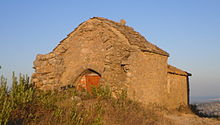Corbières (mountainous region)

The Corbières ( Catalan : les Corberes ; Occitan : Corbièras ) are a natural spatial unit within the Occitania region .
geography
The sparsely populated Corbières are located in the Pyrénées-Orientales and Aude departments . They extend from Cap Leucate , the Mediterranean coast , and the Étang de Leucate to about 130 kilometers inland, where the Corbières are cut off from the Aude River , the Pyrenees and the Pays de Sault . To the south the mountains are bounded by the river Agly , to the north by the Aude; the most important river within the Corbières is the Orbieu .
The highest point of the Corbières, the Pic de Bugarach (1230 m) is about 20 kilometers (as the crow flies) east of Quillan ; Towards the Mediterranean, the terrain slopes more and more - the mountain peaks only reach heights of around 400 meters. Most places are 150 to 300 meters above sea level.
The Corbières are divided into Corbières maritimes , Corbières interieures (also called Hautes Corbières ) and Corbières atlantiques . The Montagne d'Alaric near Carcassonne is also counted among the Corbières. The geographic differentiation of the Corbières is largely based on physical-geographical criteria, with climatic geographic and topographic features being essential. For example, the Corbières maritimes, which represent the eastern fall of the Corbières into the Mediterranean or into the Étang de Leucate , are equated with the thermo- Mediterranean vegetation level.
botany
The Corbières are very strongly influenced by viticulture ( monoculture ). In recent years, however, viticulture has declined, so that many vineyards lie fallow and are slowly being renatured. Due to the relatively dry and windy Mediterranean climate that prevails here, reforestation is mainly carried out with holm oaks , gorse and the like. Ä., So the typical garrigue plants. Larger contiguous forest areas, such as B. in southwest France, does not exist here.
Parts of the area lie in the Regional Nature Park Narbonnaise en Méditerranée .

Agriculture and viticulture
Agriculture can also be practiced in the valleys and in the foothills of the Corbières. Viticulture, beekeeping and sheep farming are the main agricultural products of the Corbières. The Corbières have a share in the following AOC wine-growing regions:
Prehistory
Near Tautavel is the cave of Arago ( la caune de l'Arago ), an internationally known fossil site, where Homo erectus bones were also excavated. In addition, there are Neolithic buildings ( dolmens and menhirs ) of the Mediterranean megalithic cultures.
history
For a long time, the barren mountains of the Corbières lay beyond history. It only appeared to be suitable as a place for skirmishes between Franconia and Saracens and as a retreat for world refugees ( monks and Cathars ). The 13th century saw renewed clashes between the French crown ( Louis IX ) and the Kingdom of Aragon . In the Peace of the Pyrenees of 1659, Roussillon and with it the Corbières finally fell to France.
Major cities and settlements
- Aude department: Lézignan-Corbières , Portel-des-Corbières , Lagrasse , Leucate , Durban-Corbières , Tuchan , Sigean , Port-la-Nouvelle .
- Pyrénées-Orientales department: Salses-le-Château , Tautavel , Maury .
Attractions
Megalithic buildings
In the Corbières there are several dolmens and menhirs from the time of the megalithic cultures (see web links).
Churches and monasteries
- Former Cistercian - fontfroide abbey
- Former Benedictine - Lagrasse Abbey
- Former priory church of St-Martin in Saint-Martin-des-Puits
- Chapelle Saint-Laurent de Moussan
- The Gorges de Galamus with the Hermitage of Saint-Antoine
- The Ermitage Saint-Victor at Fontjoncouse
Fortifications

- Ruins of the Château de Queribus
- Ruins of the Château de Peyrepertuse
- Termes Castle ruins
- Ruins of Durfort Castle
- Durban Castle ruins
- Ruins of Padern Castle
- Ruins of Aguilar Castle
- Villerouge-Termenès Castle
- Arques Castle
- Away from Salses
literature
- Michèle Aué: The land of the Cathars. Vic-en-Bigorre 1992, ISBN 2-907899-46-5 , p. 74 ff.
